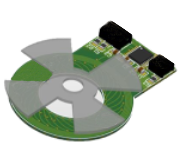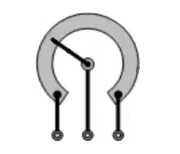A magnetic encoder is a sensor that uses magnets and magnetic sensors to measure rotational angles or positions. It consists of a rotating disk or shaft with a magnetic sensor attached, and a stationary position with magnets placed to detect the position of the rotating disk accurately.
Features
- Low noise and stable measurements
- Non-contact operation, reducing wear and potential failures
- Accurate position measurement over long distances
- High resolution for precise angle measurements
Advantages
- High durability and resistance to environmental conditions like dust, dirt, and moisture
- Suitable for applications requiring long-distance sensing and high-speed measurements
- Provides stable and reliable measurements due to its non-contact nature
- High resolution, allowing for precise angle and position measurements
Limitations
- Susceptible to magnetic interference from nearby magnets or magnetic materials
- Requires careful alignment to ensure accurate readings
- Higher cost compared to some other encoder types
Application
- Industrial Automation: Magnetic encoders are used in CNC machines, robot arms, and motors to measure their positions and rotational angles.
- Automotive and Aerospace: Used for measuring steering wheel angles in vehicles, throttle positions in aircraft, etc.
- Turret Rotation Mechanisms: Applied in laser cutting machines, automated camera equipment, and other turret rotation mechanisms.
Implementation
- Motor Control: Magnetic encoders are extensively used in motor control systems to precisely measure the position and speed of motors. They are employed in various applications, such as servo motors, brushless DC motors, and stepper motors, enabling accurate feedback for closed-loop control
- Robotics: In robotic systems, magnetic encoders are utilized in joint position control, allowing robots to move with high accuracy and repeatability. They play a crucial role in industrial robotics, collaborative robots, and other robotic applications
- Positioning Systems: Magnetic encoders find applications in positioning systems, such as linear stages and rotary tables, providing accurate position feedback for precise movements in manufacturing and scientific instruments
An optical encoder is a sensor that measures rotational angles or positions using a light source and optical sensor. It consists of a rotating disk or shaft with an optical sensor attached, and changes in optical patterns between the light source and sensor are used to detect the rotation.
Features
- High Accuracy and Resolution
- Non-contact operation, eliminating wear and contact-related issues
- Fast response time, enabling measurement of high-speed movements
- Excellent overall performance
Advantages
- High accuracy and resolution, making them ideal for precision applications
- Non-contact operation eliminates mechanical wear, ensuring longer lifespan
- Fast response time enables high-speed motion tracking
- Resistant to environmental factors like dust and moisture
Limitations
- Sensitive to dirt and debris, which may affect performance
- Ambient light interference can impact accuracy in certain conditions
- More expensive compared to some other encoder types
Application
- Robotics : Used to measure the joints and movements of robots for precise control
- CNC machines : employed to measure the position and movement of machine tools for precision machining
- Automotive Steering Systems: Apple to measure the angle of a vehicle’s steering wheel for driving control
Implementation
- CNC Machining: In computer numerical control (CNC) machining, optical encoders are employed to measure the position of machine tool axes, ensuring precise and consistent machining operations
- Automated Material Handling: Optical encoders are used in conveyor systems and material handling equipment to determine the position of goods and optimize their movement through various processes
- Printing and Packaging: In printing and packaging machines, optical encoders enable accurate positioning and synchronization of components, ensuring precise printing and packaging operations
An inductive encoder is a sensor that measures rotational angles or positions using the principle of electromagnetic induction. It consists of coils placed around a rotating disk or shaft, and changes in inductance are used to detect the rotational position.
Features
- Robust and durable design, making it suitable for harsh environments
- Detects only metallic objects, providing inherent advantages in metal detection
- Mon-contact operation, ensuring long-term reliability without wear
- Capable of accurate measurements even at high speeds
Advantages
- Robust and reliable performance in harsh environments
- Non-contact operation ensures minimal wear and extended lifespan
- Immune to non-metallic materials, making them ideal for metal detection
- Suitable for high-speed applications due to fast response times
Limitations
- Limited to metal detection applications and cannot sense non-metallic materials
- Relatively lower resolution compared to some other encoder types
- Alignment is critical for accurate readings
Application
- Automotive Manufacturing and Assembly: Used on production lines for high-speed assembly and part verification
- Industrial Automation: Applied in systems where the position and movement of heavy objects need to be detected and controlled
- High-Speed Engine Valve Control: Used in automotive engines for precise control of engine valve positions
Implementation
- Metal Detection: Inductive encoders are commonly used for metal detection applications, such as detecting metal parts in conveyor systems or verifying the presence of metal components during manufacturing processes
- Proximity Sensing: In industrial automation and automotive applications, inductive encoders are employed as proximity sensors to detect the presence or absence of metallic objects
- Speed Measurement: Inductive encoders can be used to measure the rotational speed of machines and motors by detecting the passing of gear teeth or ferromagnetic targets, allowing precise speed control and monitoring




